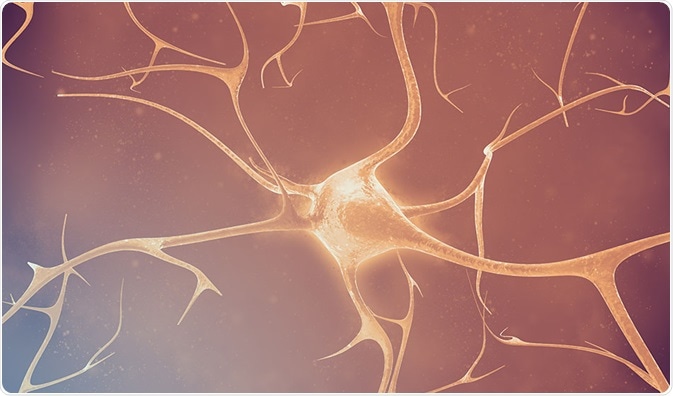What is Spinal Muscular Atrophy?

Spinal muscular atrophy (SMA) is a genetic disease that is inherited in an autosomal recessive manner.
 Credit: Rost9/Shutterstock.com
Credit: Rost9/Shutterstock.com
SMA is a neuromuscular disease that has the following clinical characteristics:
- Degeneration of lower motor neurons in the spinal cord motor (anterior horn neurons) and the brain nuclei
- Skeletal muscle atrophy due to loss of innervation, mostly proximal limb muscles
- Generalized symmetrical weakness occurs in the proximal limb muscles, progressing distally
The disease is potentially lethal and often presents in early life, that is, in infancy or early childhood, though some manifest only in adolescence or later.
Its incidence is about 1 in 6000-10 000 live births. However, 1 in 40 to 1 in 60 individuals may be carriers. There are four grades of severity, from SMA I to SMA IV, classified on the age of onset and the degree of muscular function. However, boundaries between the subtypes are not discrete.
Genetic basis
The gene which is mutated in SMA is called the survival motor neuron 1 (SMN1) gene. SMA is the result of a deletion, conversion or other changes to SMN1. Only when both alleles are homozygous for the mutation does SMA occur.
The most common cause is homozygous deletion of the SMN1 exon 7. However, the clinical severity of the condition depends also upon the number of copies of the SMN2 gene, because this produces a small part of the full-length transcribed RNA encoded by the SMN1 gene. The higher the number of SMN2 copies, the less severe the condition.
Diagnosis and treatment
Diagnosis is based upon the characteristic clinical features of progressive proximal limb weakness and muscle atrophy. A confirmatory diagnostic test demonstrates the presence of homozygous SMN1 mutations. This has a sensitivity of about 95% and almost 100% specificity. Other conditions which should be ruled out include nonrelated causes of hypotonia or limb girdle weakness.
Carrier testing is of great use and in frequent demand by siblings or parents of affected individuals when making reproductive decisions. The pattern should be to test related individuals first and when the test is positive, to screen the spouse or partner.
Siblings might benefit from full neurological testing coupled with direct testing. Couples who have had a baby with SMA should be told of the 25% risk of recurrence with each conception, and presented with the option for prenatal diagnosis.
SMA is incurable by external medical measures. However, when it is chronic in nature and presents later in life, mortality is not increased above the population mean. However, most individuals with SMA I have a high risk of dying within the first year of life.
Complications include joint contractures, poor lung development and respiratory infections, failure to grow normally, and scoliosis.
At present, multiple disciplines must collaborate to provide optimal care for the affected individuals. This includes care of the neuromuscular system, the lungs which are liable to congestion, nutritional care, and orthopedic care including surgical repair of scoliosis or joint contractures.
However, several potential treatment strategies are under development and may be available in the future to treat these patients. Transgenic mice have been created to test some of these treatment models. Drugs which increase SMN2 function are also likely to be useful in mitigating the symptoms of SMA.
Credit: Osmosis/Youtube.com
Reviewed by Afsaneh Khetrapal Bsc (Hons)
Sources
- https://www.ncbi.nlm.nih.gov/pubmed/18572081
- https://www.ncbi.nlm.nih.gov/pmc/articles/PMC4628728/
- https://www.ncbi.nlm.nih.gov/pmc/articles/PMC4514700/
- https://www.ncbi.nlm.nih.gov/pmc/articles/PMC3231874/
- https://www.ncbi.nlm.nih.gov/pubmed/20301526
Further Reading
- All Spinal Muscular Atrophy Content
- Spinal Muscular Atrophy Symptoms
- Spinal Muscular Atrophy Diagnosis
- Spinal Muscular Atrophy Research
- Spinal Muscular Atrophy Causes
Last Updated: Mar 7, 2019

Written by
Dr. Liji Thomas
Dr. Liji Thomas is an OB-GYN, who graduated from the Government Medical College, University of Calicut, Kerala, in 2001. Liji practiced as a full-time consultant in obstetrics/gynecology in a private hospital for a few years following her graduation. She has counseled hundreds of patients facing issues from pregnancy-related problems and infertility, and has been in charge of over 2,000 deliveries, striving always to achieve a normal delivery rather than operative.
Source: Read Full Article